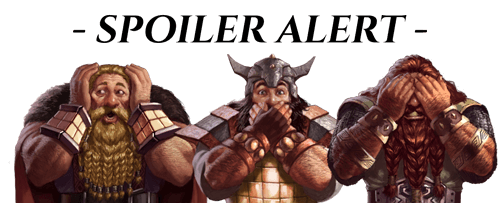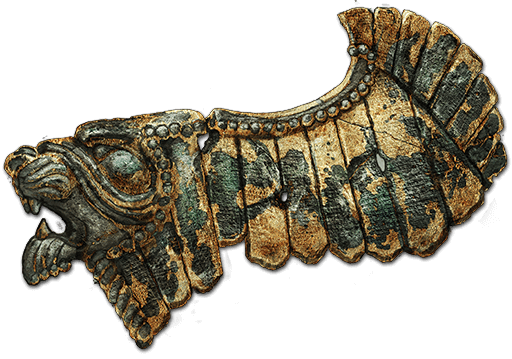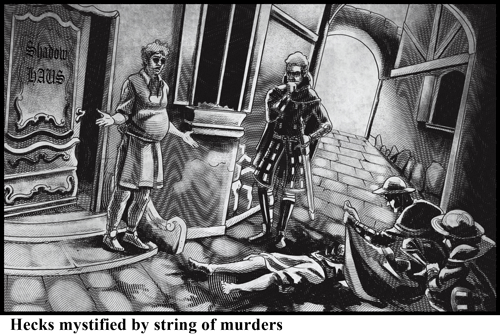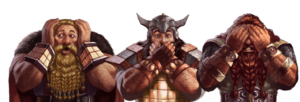
Shelby Chartrand, Augstat, Hesse
An unidentified woman lies dead at the mortuary in Boars Kriese, ferociously attacked by a wild animal in the wee hours of Sunday morning.
Shadoweg, a seedy gang-controlled Boars Kriese neighborhood, features overcrowded slums filled with flophouses, abattoirs, pubs, warehouses, and shabby labor-class tenements.
A Kordavan Informant newsy named Rufus was selling papers on the corner of Shadoweg and Wild Swine Road when he heard a commotion and dogs barking. He was about to investigate when he saw the body of a woman lying in a pool of blood in the alley next to Shadow Haus, a popular watering hole frequented by citizens of the boar.
Rufus at once called the Hecks, who at first declined to respond. After he flagged down a passing merchant, however, the Hecks were more inclined to investigate. Rats feasting on the corpse had to be shooed away in order to examine the girl. After a quick assessment, the knights pronounced the victim dead, her throat savagely ripped out as if by a beast, her chest and abdomen gored.
The owner of Shadow Haus said he closed around 4 o’clock in the morning; he recalled seeing drunken loiterers around a burn barrel but remembered nothing more nefarious. “I would have tripped over the poor fräulein, had she been there at that time.”
A Heck officer said they had found a woman’s purse with two silver pfennigs and a few coppers nearby. No weapon or other evidence appeared to be left behind by the assailant. The victim was a human in her early to mid-twenties with long blonde braided trusses and a thin face and build. According to officials, she likely belonged to the lowest class.
This is the third such attack in Boars Kriese over the last month and the twelfth in the last six. Packs of feral dogs roam at night, hunting for easy pickings. One officer noted, “they’ve been known to attack children on occasion but not an adult. Until this.”
The body has been removed to Boars Kriese mortuary, and the Hecks are making enquiries—but given the mysterious nature of this and other recent related attacks, and without an eyewitness or irrefutable evidence, officials concede there is little hope of finding the assailant. With mounting pressure from local merchants to do more, the Hecks have agreed to step up patrols in Boars Kriese.


Spreck Spivey, Augstat, Hesse
At the center of Niessia, between the kingdoms of Stollhofen and Mycenea, lies Greymory, a gray swamp of a wasteland, a ghoul that slowly eats away at the marrow of Chaldea. Little is known about the Greymory Wastes; it is hermit kingdom, worthy only of to ill-omen speculation and backward theories regarding its creation. Emperor Kordaava subdivided Chaldea into individual and succinct kingdoms and free city state, each actively governed to maintain world order and to bring an official end to the Dark Times.
But then, why Greymory?
Greymory, while technically a kingdom by imperial proclamation, functions more like a covert oligarchy. Neighboring kingdoms are not known to share treaties or trade in or out of Greymory, and while the borders are open to travel, no known trade routes cross those borders; instead, almost all commercial trade proceeds north through Himyar.
Who or what rules this blighted land? There are no cities, settlements, or anything more than a few nomadic humanoid tribes of orcs, goblins, and gnolls. At the center of Greymory is a giant lake, better described as a morass of gray, oozing mud with black, watery veins. Brackish rivers flow in and out of Greymory and are described rather than named: “Slime,” “Mud,” and “Putrid.” By their labels, these rivers describe the unhealthy state of Greymory.
If Greymory possesses a ruling culture, it is centered at Blackheath, a squat round tower on the island at the center of the lake. To date, however, none dare cross the lake for fear of disease associated with the wastewaters. Further, rumors abound of mutant creatures and animals that exist in the bogs bordering the lake—twisted, unnatural, and with monstrous abnormalities. A curse against nature, they are so described, and all that is good and wholesome. Gravers for decades have sought to penetrate this veil of secrecy, and yet we still know very little of their encounters or the kingdom at large itself.
One must ask, then: what did Emperor Kordaava know about Greymory that made him isolate it in such a manner?


Dietta the Mouse, Augstat, Hesse
For a brief few weeks, exciting news of a dwarven birth spread like wildfire out of Stolhoffen, moving like gossip from lip to ear throughout Hesse and ultimately to the world beyond. Gekkons and gnubbles worked furiously to deliver the joyous news faster than a classroom note between young lovers.
More than forty years have passed since the last documented dwarven birth—thus, when the momentous news broke like a tidal wave, the world was gripped with jubilance. The occasion captivated high society and main street in equal measure. For one shining moment, the world was a bit brighter, glad hearts celebrated, and many across the land expressed genuine pleasure for dwarves.
Digger’s Dump, the freehold of Augstat’s Clanless dwarves, burst into a raucous spontaneous jamboree. Wine casks and mead kegs were broken wide, and the dwarves in high spirits offered free drinks to passersby, all to the backdrop of lively music played loudly all the night long. In Alterflector, fireworks were fired over Rubenstein for seven straight nights, and businesses about the city celebrated by shutting their doors early and taking to the streets in fellowship with friends. Spirits were high all over Augstat—like the tide that lifts all ships, the news of a dwarven child lifted all spirits.
In the Claw Hammer War, the dwarves had faced genocide and had survived only by hope and the thinnest of margins; even now, historians are mystified as to how they escaped dragon wrath and sell-sword armies. In the thousand years since, scant those few dwarves endured on the edge of extinction and faced constant fear, dilemmas, and hardships. Those who weren’t slaves were treated just as poorly.
“Bearing children has never been easy,” said Beset Ferg, a Clan Ferg elder in their clan hall south of Enchantments Guard. The elder was cordial and casual, happy to discuss the dwarven fertility challenge her people faced, in case someone, somewhere, should have a solution for the race’s ailment. “We dwarves have large families only because we are long lived. Lately, our difficulty has increased.
“Not a single child.” She stopped momentarily, choking back her tears. “In forty years, not a single child. Not a blessed one.”
The last publicized births were forty-one years ago: Kwell Geldzahn of Clan Geldzahn in Saratof and Serakka Cloudforge of Clan Cloudforge, also from Saratof. We know their names only due to the rarity their births represent. If there have been others since, there is no record to be found.
What, then, is the cause of the dwarven infertility?
“It’s them fucking dragons!” said Fug, a Clanless dwarf chugging ale in Digger’s Dump Ale Reserve with fifty of his closest comrades.
“Aye!” yelled the lot in unison. For a good while, insults and ear-burning profanity reverberated around the hall as axes filled the air, flung at a shoddy illustration of a dragon on the far wall.
“’Tis a terrible hex,” said Marthmaulla, a street captain with the 9th Avenue Punks, a minor gang of dwarven outcasts, “dragon mages working their potent planar magic against us. Them fire breathers don’t give up, ever, you understand? Sleeping and plotting—that’s the culmination of their existence, see?”
Fug drove an enchanted mallet into the floor with a crack of thunder. His eyes flared red with fury and hate. “Claw versus hammer,” he said. “That’s what it is, that’s what it’ll always be. Them or us.”
Modafferi, an elven midwife from the Garnon Lodge of Ritual and Ceremony and an expert in the field of fertility, has consulted with many dwarven couples in the past and concedes frustration. “Strange doesn’t begin to describe it. There is no physical reason that I can ascertain why dwarven women are not conceiving.”
Asked to speculate, Modafferi replied, “Speculation is a poor soul’s lie weaved from ignorance.”
In the days that followed, gifts and letters of congratulations from all over the empire arrived at Kurighaul, the home of the alleged newborn. The manic exuberance suddenly turned sour. The tides of disinformation rose, and the house was dashed, and the hopes and dreams of the dwarven people were equally destroyed. The Stolhoffen Clan had been slow to react to the swift spreading news that had struck like the first rays of the morning sun.
Finally, a lone messenger was dispatched from Kurighaul with a terse public statement: “News of a Stolhoffen Clan birth is patently false.”
How could such an apparent ill-founded rumor begin in the first place?
Sources close to the story in Stolhoffen’s Kurighaul fortress, who requested to remain anonymous, said, “There was definitely a childbirth.”
A caucus of midwives had allegedly arrived a few weeks earlier. Just before the rumors of a birth surfaced, servants reported hearing “a baby cry and women wailing.”
Additional evidence came in the form of a brigade of Dwarven Host summoned to Kurighaul: one-hundred-and-fifty elite Host Guards of the Household Brigade stationed visibly in and around the fortress. Grand Master Kane Kurig was confirmed as having arrived, reportedly bearing gifts. Later, he left visibly upset, hurling insults at nearby soldiers. The Round Tower in Augstat released a statement, insisting, “Grand Master Kane Kurig is away on family business.”
Clair, the owner of Clairvoyeurism in the town of Gutenfels and a local anumian seer, revealed she met with Landgrave Gurk and Fulda of Kurighaul. “They came to me a couple of years ago, desperate for a child. Willing to do just about anything to conceive. Cute couple but sad. They’d tried just about everything and consulting the anumians was their last, best hope.”
Asked if they were successful, Clair responded sternly, “I am always successful. But it is not my place to say more.”
A group of gravers out of Leblon, Salominica, specializing in raids into Niesse and orc slaying, reported assisting a dwarven couple matching the description of Landgrave Gurk and his wife out of Niesse.
“They were in dire straits,” said Entdash, an elven ranger. “The husband was beaten half-dead and the lady, she was pregnant to the point of birthing. We found them just North of Gloggu near Har Mesa, surrounded by the bodies of twenty dead orcs. The Landgrave had just finished off one of these elite, sun-defying bastards.”
Was the Lady Fulda truly pregnant?
“Even with child, she put on a good showing,” Entdash said. He and his graver friends gave aid to the couple’s wounds and delivered them to Harhaul, hoping to claim a reward for saving the Landgrave, but as soon as the Host Guard saw the pregnant lady, she was taken from sight, and the gravers were forced from the property, a few silver tossed into the dirt for their effort.
“They were on some kind of anumian fertility quest,” the ranger replied when asked if he knew why the couple had been in Niesse. “When an anumian sends you on a quest, you best go the other direction. This is what I say. Better still, do not draw their damned card in the first place.”
Back in Gutenfels, Clair shuffled a deck of Anumian Fate cards, refusing to confirm if it were, indeed, Fulda who was pregnant. Instead, she volunteered this advice: “Calling upon an anumian does not come without its perils. Nabu Pabu, the Akkadian seer, built a career warning people about the dangers of summoning anumians. The old adage still holds water: desperate times call for desperate anumians.”
Nabu Pabu writes, “The result you desire is not always the one you receive.”
Are the dwarves facing an extinction level event, unable to procreate? Or might dwarven children, like the one in Kurighaul, be tactfully and mysteriously kept from public view?
For the sake of our dwarven friends, let us hope and pray we soon hear the happy cry of children’s voices at play in dwarven homes.


Hasala of Stahleck, Augstat, Hesse
An Aimilleuse painter and self-described lover of maps, Étienne de La Havre, recently released his latest masterpiece, “Le Monde,” A map painting of Chaldea that is part of a touring art exhibition visiting major cities around the world. Currently the exhibition is drawing large crowds in Perrin in the City of Gleam.
The colorful map erroneously depicts all the world’s continents clustered in close-proximity to one another.
“Yes,” said, Étienne in defense of his painting, “I recognize the continents are not positioned thusly—it is a celebration of Chaldea, not a geography lesson. Is it not beautiful?”
Indeed, the map is a wonderful example of Aimilleuse impressionist beauty, but academics stand in exasperated agreement about the specifics of the work.
“He’s intentionally spreading misinformation and, in truth, lies,” said, Sokolov, a major member of the Lazzaretti Gold School of Cartography in Saratof and author of the bestselling Anumian Travel Atlas. “Perrin and Ata-Aimilleuse are not neighbors any more than Niessia and Akkadia are. The continents of Chaldea are in constant motion, shifting on the mystical Great Sea like leaves on an autumn pond. Looking at this ridiculous painting, one would think you could simply sail west from Perrin and make landfall in Aimilleuse. This would never happen in many generations, would it not? Such ideas are not merely wrong, but they are dangerous! Sailing without the aid of anumians, you would be fortunate if to not be caught in the Dorsang Drift and lost in the Great Sea for many months, if not forever.”
Ocean navigators dedicate their lives to studying Anumian constellations and spend a fortune acquiring the Fate cards required to safely navigate the Great Sea. “We spend our careers traveling the world, creating precision maps and providing helpful hints and tricks to journey. All that painstaking sweat is put in jeopardy by this marn-minded fool,” said an aggravated Sokolov.
Étienne is no stranger to controversy. A few years ago, he sculpted a marble statue entitled “Orc Love,” which scandalously depicted an elf making love to an orc. The statue stood outside the arts exhibition center in Saratof for one anumian before it was defaced by angry elf protesters.


Shelby Chartrand, Augstat, Hesse
The Tartu Musical Society, a bohemian bard troop from the Garnon town bearing the same name, gave a spontaneous live performance of The Garnon Sylph last evening in the historic Edlers Bowl, surprising passersby with vibrant song and dance in the city’s most enchanted concert venue.
Crowds quickly gathered, captivated by the exhilarating performance of the live performance, supernaturally enhanced by magical lights, sounds and pyrotechnics, and directed by a magician maestro wielding an arsenal of pixie wands.
Performers dressed as fairies danced through the crowd, and at the performance’s climax, golden pixie dust rained down upon the crowd, enchanting everyone to their feet in a grand dance finale that led to the biggest surprise of the evening: the appearance of Ballerina. The anumian appeared as a dancing star in the distant sky, and as she weaved and bobbed, performing pirouettes and arcing skyhooks, her form grew larger and larger until the constellation held sway over the entire bowl, the crowds dancing and singing below cheered madly. And then, at the peak of an exuberant crescendo from the crowd, she was gone, bringing to an end the spontaneous Theatre Under the Anumians.
The Tartu Musical Society is preparing for a new concert series that kicks off next month. “We decided Augstat would be a perfect location for a dress rehearsal,” said the pixie troop maestro, Fydylstyks le Fey. “No fees, no fees, just fun, fun, fun.”
When pressed if they plan to summon Ballerina at each performance, he exclaimed, “Non, non, non. We did not summon the great dancer. Gods non.” He fainted dramatically to the ground, only to spring to his feet once more. “She arrived, oui, she did, and to much applause for our performance. It is good, non?”
Good, oui. I suppose there is no better review one can receive than Ballerina making an appearance at your performance. Mark this event in the future on your calendar; it is well worth your time and coin.



K.I. Issue #103 contains potential spoiler material.
DO NOT READ
until after viewing…


Issue #103






